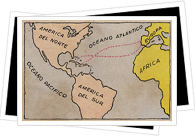The history of Latin America can be traced back thousands of years.

The first settlers of the American continent were believed to have come from Asia, navigating the Bering Strait.

Often called the new world, Christopher Columbus put the Americas on the map in 1492 when he made his voyage across the Atlantic into the unknown.
At the time, the Europeans could never have imagined that the 'savages' found in the new world were descended from so many great empires.
Archaic Period: 30,000BC to 2000BC
10,000 to 30,000 Waves of people travel the Bering Strait, travelling south through the Americas
11000 to 2000 Agricultural lifestyle begins
2600 Maya civilisation begins
Pre-classic Period: 2000-200 BC
2000BC to 1000AD Machallia people - Ecuador coast
2000BC to 300AD Olmec civilisation
900 to 200BC Chavin culture - Peru highlands
Classic Period: 200BC to 1000AD
200 to 750 Classical Mexican civilizations: Teotihuacan - Valley of Mexico, Monte Alban - Oaxaca
200BC to 600AD Nazca - Peruvian coast
300 to 900 Classical Mayan civilization - Yucatan Peninsula
450 to 750 Theocratic empire - Teotihuacán, Mexico
550 to 1000 Tiwanaku empire - Lake Titicaca, Peru
600 to 800 Huari (Wari)- Peruvian Highlands
900 to 1200 Toltec civilization - Mexico
Post-classic Period: 1000 to 1492AD
1000 to 1476 Chimú empire - Peru
1224 to 1461 Itza (Uicil-abnal) people - Yucatan, Mexico
1345 to 1519 Aztec Empire - Mexico
1350 to 1533 Inca Empire - Peru
1492 Europeans 'discover' the continent and begin the Colonial period

